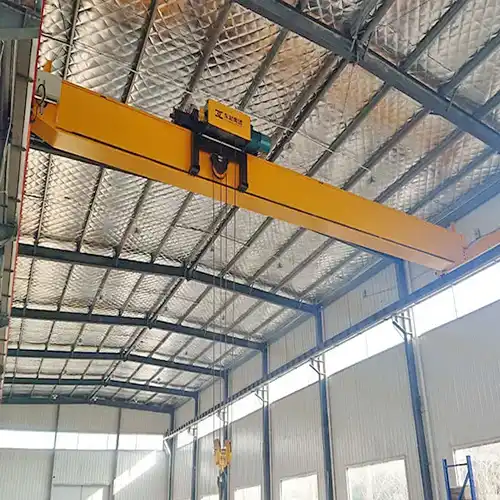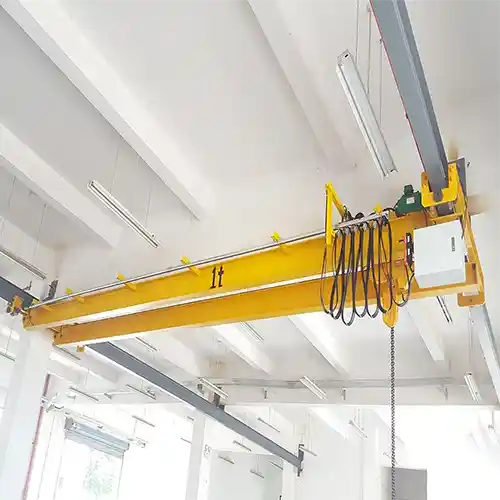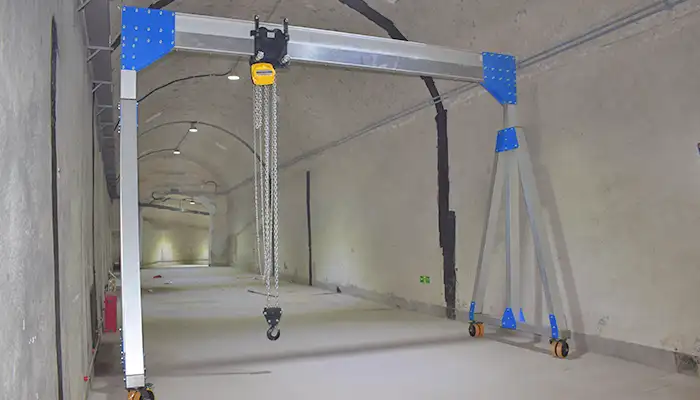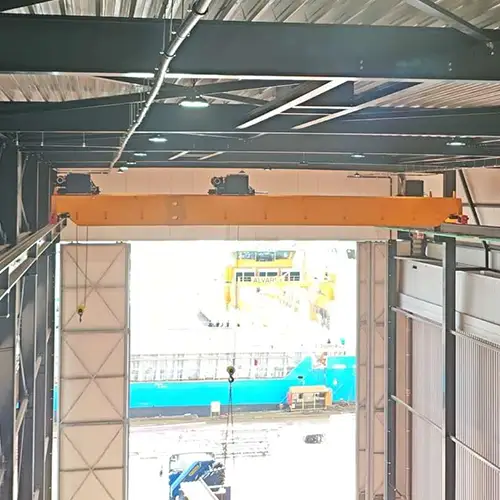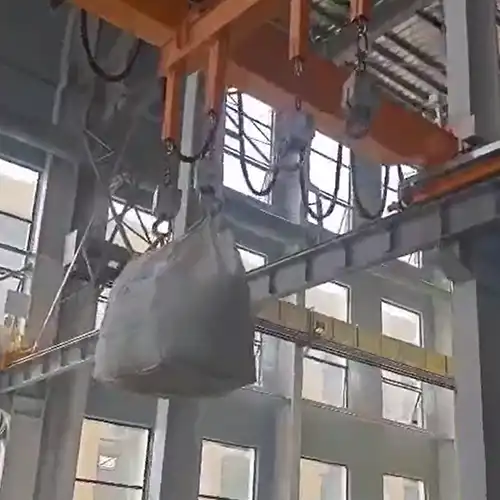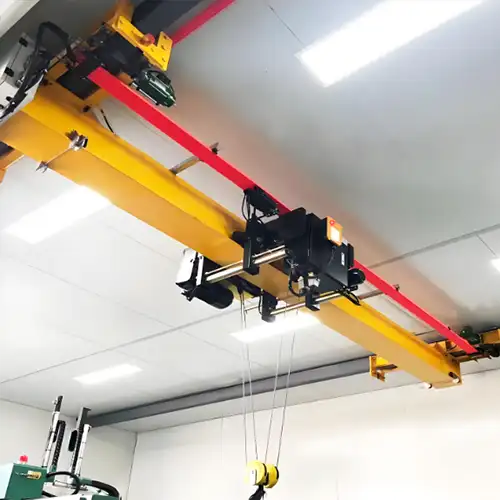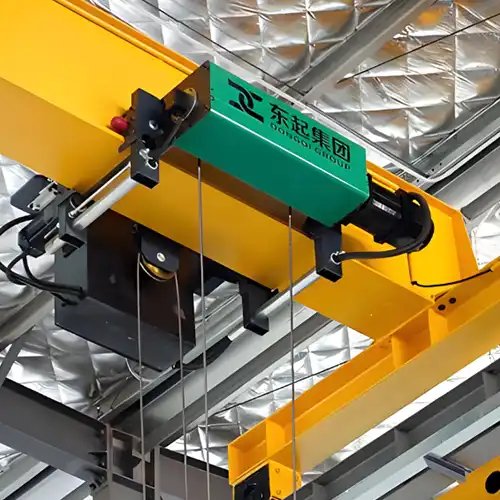Single & Double Girder Low Profile Bridge Cranes 1 Ton to 80 Ton
Low profile bridge crane is a versatile solution designed to streamline material handling operations while optimizing floor space 1 ton to 80 ton. Click!
| Crane type | Low profile bridge crane |
| Single girder design | 1 ton to 20 ton |
| Double girder design | 3 ton to 80 ton |
| Note | Custom design low profile cranes are available. |
Category: Low Built Cranes & Hoists
Your Trusted Low Profile Crane Manufacturer & Supplier
Single & Double Girder Low Profile Bridge Cranes 1 Ton to 80 Ton
Streamline Material Handling Ooperations & Optimizing Floor Space
Single & Double Girder Low Profile Bridge Cranes 1Ton to 80 Ton. Low profile bridge crane is a versatile solution designed to streamline material handling operations while optimizing floor space 1 ton to 80 ton. Click!
Low Profile Bridge Cranes: Enhancing Efficiency in Industrial and Workshop Settings
Low profile bridge crane is a versatile solution designed to streamline material handling operations while optimizing floor space.
Low profile bridge cranes are specialized lifting systems characterized by their compact design and low clearance requirements. Unlike traditional overhead cranes, which often require substantial overhead clearance, these cranes are engineered to operate within constrained spaces without compromising on lifting capacity or functionality.
Importance in Industrial and Workshop Settings
These cranes play a crucial role in modern industrial settings and workshops for several compelling reasons:
- Space Efficiency: Traditional cranes often monopolize overhead space, limiting the layout flexibility of workshops. Low profile bridge cranes, with their minimal vertical clearance needs, allow for better space utilization. They can operate effectively in environments where ceiling heights are restricted, maximizing usable floor area for other operations or storage.
- Enhanced Maneuverability: The compact nature of low profile bridge cranes enables them to navigate tight spaces with ease. This maneuverability is invaluable in workshops where aisles may be narrow or where precise positioning of heavy loads is required.
- Improved Safety: By operating closer to the ground compared to traditional cranes, low profile bridge cranes reduce the risk of accidents related to overhead clearance. This enhances safety for both equipment and personnel, particularly in busy work environments.
- Cost-Effectiveness: Installing low profile bridge cranes can be a cost-effective solution, especially when retrofitting existing workshops or designing new facilities. They require less structural modification and are often quicker to install compared to larger, more cumbersome crane systems.
In essence, low profile bridge cranes represent a smart investment for businesses aiming to optimize their operational efficiency, safety standards, and overall workspace utilization. Whether used in manufacturing, assembly lines, or maintenance facilities, these cranes epitomize innovation tailored to meet the evolving needs of modern industry.
Types of Low Profile Bridge Cranes
When it comes to optimizing space and efficiency in industrial and workshop environments, understanding the types of low profile bridge cranes available is crucial. Let's delve into the specifics of single girder low profile bridge cranes, their design, capabilities, and advantages over traditional crane systems.
Single Girder Low Profile Bridge Cranes
Design and Configuration
Single girder low profile bridge cranes are characterized by their simplified design, featuring a single beam (girder) that spans the width of the crane runway. This design minimizes the crane's weight and profile, allowing it to operate effectively in facilities with limited overhead clearance.
Typical Load Capacities
These cranes are typically designed to handle moderate to heavy loads, ranging from a few hundred kilograms to several tons, depending on the specific model and application requirements. The load capacity can be customized to suit the needs of various industries, from light manufacturing to heavy industrial settings.
Advantages over Traditional Cranes
- Space Optimization: Unlike traditional double girder cranes, which require more vertical space, single girder low profile bridge cranes can operate in facilities with lower ceilings or restricted overhead space. This flexibility in height requirements allows businesses to maximize their floor space for other essential operations.
- Cost-Effectiveness: The simplified design of single girder cranes often results in lower manufacturing and installation costs compared to their double girder counterparts. Additionally, maintenance and operational expenses may be reduced due to fewer components and simpler maintenance procedures.
- Ease of Installation: Installing single girder low profile bridge cranes is typically quicker and less disruptive to ongoing operations. They require less structural support and modification, making them ideal for retrofitting existing workshops or integrating into new facility designs without extensive construction delays.
These advantages make single girder low profile bridge cranes a practical choice for industries seeking efficient material handling solutions without compromising on performance or safety. Whether used in manufacturing, warehousing, or assembly lines, these cranes exemplify innovation tailored to meet the operational challenges of today's dynamic industrial environments.

LD Low Profile Bridge Crane with Low Headroom Hoist
- Design and Configuration: The LD low profile bridge crane features a single girder design optimized for low headroom applications. It is equipped with a specialized low headroom hoist that allows the crane to operate efficiently in spaces where vertical clearance is limited.
- Typical Applications: Ideal for facilities with low ceilings or structures where maximizing vertical space is critical. Commonly used in manufacturing plants, assembly lines, and workshops where overhead clearance is a concern.
- Advantages: Offers significant space savings compared to traditional overhead cranes, allowing for better utilization of floor space. The low headroom hoist ensures optimal lifting capabilities without compromising on operational efficiency.
LDP Low Headroom Bridge Crane with Hoisting Trolley Placed Aside of the Main Girder
- Design and Configuration: The LDP low headroom bridge crane features a unique design where the hoisting trolley is positioned beside the main girder rather than beneath it. This configuration further reduces the crane's profile, making it suitable for environments with extremely limited headroom.
- Typical Applications: Well-suited for workshops or facilities where the crane must navigate through narrow passages or operate in confined spaces. Used in industries requiring precise load positioning and flexibility in material handling.
- Advantages: Maximizes available overhead space by eliminating the need for a traditional hoisting trolley beneath the girder. Provides enhanced maneuverability and operational flexibility, making it a preferred choice for industries with stringent spatial constraints.

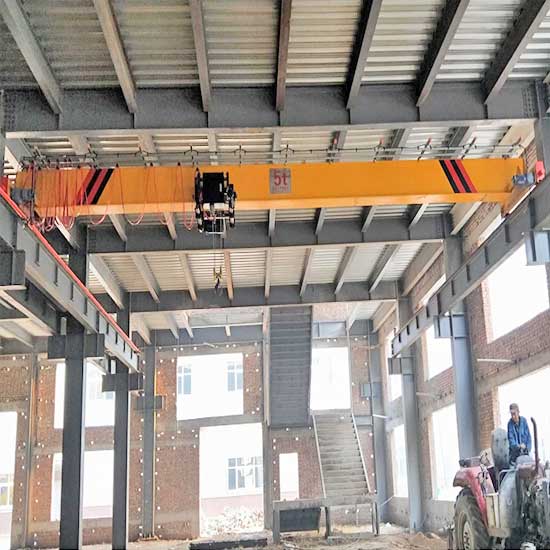
HD Low Profile Bridge Cranes with European Style Low Headroom Hoist
- Design and Configuration: The HD low profile bridge crane incorporates a European-style low headroom hoist, characterized by its compact and efficient design. This crane is engineered to optimize lifting performance while minimizing overall crane height.
- Typical Applications: Suitable for heavy-duty industrial applications where robust lifting capabilities and durability are paramount. Used in environments requiring frequent and reliable material handling operations.
- Advantages: Combines the benefits of a low profile design with the reliability and strength of European engineering standards. Provides superior load handling capacities and operational longevity, making it ideal for demanding industrial settings.
These types of single girder low profile bridge cranes exemplify innovative solutions designed to meet diverse operational needs while addressing space limitations in industrial and workshop environments. Whether enhancing efficiency in manufacturing processes or improving material flow in assembly lines, each configuration offers distinct advantages tailored to specific industry requirements.
Double Girder Low Profile Bridge Cranes
In contrast to their single girder counterparts, double girder low profile bridge cranes offer enhanced strength and versatility, making them indispensable in heavy-duty industrial applications. Let's explore the structural differences, suitable applications, and benefits of these robust crane systems.
Structural Differences Compared to Single Girder
- Dual Girder Design: Double girder low profile bridge cranes feature two parallel girders that span the crane runway. This design provides increased stability and lifting capacity compared to single girder cranes.
- Height Profile: Despite their dual girder configuration, these cranes are engineered with a low profile to operate effectively in facilities with limited overhead clearance. The robust structure allows for higher load capacities without compromising on vertical space requirements.
Suitable Applications
- Heavy-Duty Industries: Designed to handle substantial loads ranging from several tons to over a hundred tons, double girder low profile bridge cranes excel in heavy-duty industrial applications. Industries such as steel mills, foundries, automotive manufacturing, and aerospace rely on these cranes for their robustness and reliability.
- Precise Material Handling: Ideal for environments where precise positioning and control of heavy loads are critical. The dual girder design provides superior stability and rigidity, ensuring accurate material handling operations even under demanding conditions.
Benefits in Heavy-Duty Environments
- Increased Load Capacity: The dual girder configuration allows for higher load capacities compared to single girder cranes. This capability is essential in industries where lifting heavy and bulky materials is routine.
- Enhanced Durability: Built to withstand rigorous use and challenging environments, double girder low profile bridge cranes offer exceptional durability and longevity. They are designed to minimize downtime and maintenance costs associated with frequent operations.
- Versatility: Suitable for a wide range of lifting applications, including tasks that require precise control and maneuverability. The dual girder design provides flexibility in handling various load types and sizes, adapting to evolving production needs.
- Safety and Stability: The robust structure and enhanced stability of double girder cranes contribute to safer working conditions. They reduce the risk of load sway and ensure secure handling of heavy materials, promoting workplace safety.
In summary, double girder low profile bridge cranes represent a reliable solution for heavy-duty industrial operations where strength, durability, and precise material handling capabilities are paramount. Their structural integrity and versatility make them indispensable assets in modern manufacturing and production facilities, ensuring efficient and safe handling of heavy loads.
Types of double girder low profile bridge cranes
Double girder low profile bridge cranes are versatile heavy-duty lifting solutions designed to optimize space utilization while offering robust performance in industrial settings.
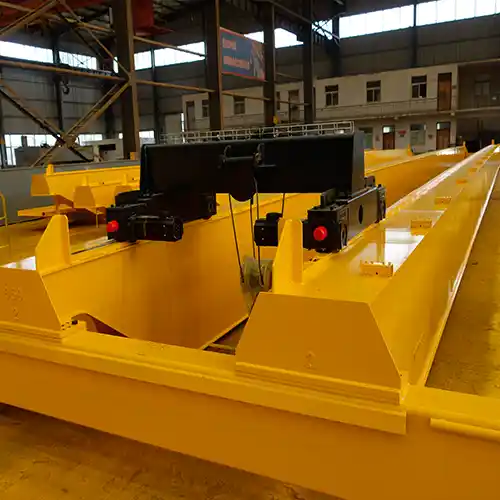
Double Girder Electric Hoist Low Profile Bridge Cranes
- Design and Configuration: These cranes feature two parallel girders that span the crane runway, supporting an electric hoist system. The electric hoist is mounted between the girders, offering efficient vertical lifting capabilities with precise control and positioning of heavy loads.
- Suitable Applications: Widely used in industries requiring high lifting capacities and precise material handling, such as steel production, heavy manufacturing, and shipbuilding. They excel in environments where large and heavy materials need to be moved with accuracy and efficiency.
Benefits:
- High Lifting Capacity: Capable of handling loads ranging from several tons to over a hundred tons, depending on the specific model and configuration.
- Precise Control: Electric hoists provide smooth lifting and lowering operations, allowing for accurate placement of loads.
- Enhanced Safety: Equipped with advanced safety features like overload protection and emergency stop systems to ensure safe operations in heavy-duty environments.
- Longevity: Built to withstand continuous use and demanding conditions, minimizing downtime and maintenance costs.

Double Girder Open Winch Low Profile Bridge Cranes
- Design and Configuration: These cranes utilize an open winch system mounted on the bridge structure between the double girders. The open winch design offers flexibility in handling various load sizes and types, accommodating the specific needs of different industries.
- Suitable Applications: Commonly used in industries such as paper mills, power plants, and heavy equipment manufacturing, where the versatility of the open winch system is advantageous.
Benefits:
- Versatility: Open winch systems can accommodate a wide range of hoisting requirements, including lifting speeds and load capacities tailored to specific operational needs.
- Adaptability: Ideal for applications where frequent changes in load sizes and configurations are common, providing operational flexibility.
- Efficiency: Optimized for efficient material handling with fast lifting speeds and precise load control, enhancing overall productivity.
- Durability: Designed for reliability in harsh environments, ensuring consistent performance and minimal downtime.
These types of double girder low profile bridge cranes exemplify advanced engineering solutions that combine heavy lifting capabilities with space-saving designs, meeting the rigorous demands of modern industrial operations effectively.
Designs and Configurations of Low Profile Bridge Cranes
Low profile bridge cranes come in various designs and configurations to meet specific operational needs and spatial constraints within industrial and workshop environments.

Features and Benefits:
- Sturdy Construction: The box girder design consists of a closed rectangular section, providing superior stiffness and resistance to torsion. This robust structure enhances the crane's stability and load-bearing capacity.
- Reduced Deflection: Compared to I-beam girders, box girders offer lower deflection under load, ensuring more precise load positioning and control.
- Aesthetic Appeal: Box girders often have a sleek and modern appearance, making them suitable for applications where aesthetics are important.
Application Suitability:
- Heavy-Duty Industries: Ideal for heavy manufacturing sectors such as steel mills, foundries, and automotive plants where high load capacities and rigidity are essential.
- Long Span Requirements: Suitable for applications requiring longer spans between crane supports, accommodating large work areas without compromising structural integrity.
Construction and Operational Advantages:
- Versatility: I-beam girders are versatile and widely used in various crane applications due to their simple and effective design.
- Cost-Effective: Generally more economical to manufacture and install compared to box girders, making them a practical choice for budget-conscious projects.
- Ease of Maintenance: I-beam girders are easier to inspect and maintain, with accessible surfaces for cleaning and repairs.
Limitations and Considerations:
- Deflection: I-beam girders may exhibit higher deflection under load compared to box girders, potentially affecting precision in load handling.
- Heavy Loads: While capable of handling substantial loads, I-beam girders may require additional reinforcement or larger sections for heavier applications.
- Environmental Factors: Considerations such as corrosion resistance and exposure to harsh environments should be addressed through proper coating and maintenance practices.

- Tailored Solutions: Beyond standard box and I-beam girder designs, customized low profile bridge cranes offer flexibility to meet unique operational requirements.
- Integration with Existing Infrastructure: Custom designs can incorporate specific features to integrate seamlessly with existing workshop layouts and structural constraints.
- Specialized Applications: Tailored designs can optimize crane performance for specialized tasks such as precise material handling in clean room environments or corrosive-resistant coatings for marine applications.
- Innovative Technologies: Incorporating advanced technologies like automation, remote monitoring, and adaptive control systems can enhance operational efficiency and safety.
Customized designs ensure that low profile bridge cranes not only meet but exceed expectations in terms of performance, reliability, and adaptability to diverse industrial settings. Whether enhancing productivity in heavy-duty manufacturing or accommodating unique spatial challenges, these designs reflect ongoing advancements in crane engineering tailored to modern industrial demands.
Typical Low Profile Crane Hoists
Efficient material handling in industrial and workshop settings often relies on specialized hoisting systems tailored to specific operational needs. Let's explore two common types of hoists used in low profile bridge cranes: Electric Wire Rope Hoists and Chain Hoists.

Chain Hoists
Design Specifics:
- Mechanical Advantage: Chain hoists utilize a lifting chain mechanism driven by a manual or electric motor, providing robust lifting power in a compact form factor.
- Durability: Designed for durability and reliability in various industrial environments, with hardened steel chains and sturdy construction.
- Usability in Various Industries:Chain hoists are versatile and find applications in industries such as construction, maintenance, and warehousing where heavy lifting and precise load control are essential.
Maintenance Requirements:
- Regular inspection and lubrication of chains and pulleys are necessary to ensure smooth operation and extend the hoist's lifespan.
- Electrical components (in electric chain hoists) require periodic checks to maintain optimal performance and safety standards.
Electric Wire Rope Hoists
Features and Benefits:
- Smooth Operation: Electric wire rope hoists offer precise control over lifting and lowering speeds, ensuring smooth and efficient material handling.
- Versatility: Suitable for a wide range of applications due to their ability to handle various load sizes and configurations.
- Compact Design: Ideal for low profile bridge cranes where space-saving solutions are crucial, minimizing overhead clearance requirements.
- - Load Handling Capacities:Electric wire rope hoists can handle loads ranging from light capacities of a few hundred kilograms to heavy-duty capacities exceeding several tons, depending on the specific model and application requirements.
Safety Considerations:
- Overload Protection: Integrated safety features such as overload limiters and emergency braking systems ensure safe operation under maximum load conditions.
- Remote Control Options: Remote control capabilities allow operators to maintain a safe distance during lifting operations, enhancing workplace safety.
- Maintenance Alerts: Some models feature diagnostic systems that alert operators to maintenance needs, ensuring continuous reliability and safety.

Electric wire rope hoists and chain hoists are integral components of low profile bridge cranes, each offering unique advantages suited to different operational environments and requirements. Whether optimizing efficiency in manufacturing processes or ensuring safe and reliable material handling in workshops, these hoists exemplify innovation in crane technology tailored to meet the diverse needs of modern industries.
Applications of Low Profile Bridge Cranes
Low profile bridge cranes play a pivotal role in enhancing operational efficiency and space utilization across various industrial and workshop settings. Let's explore their applications in both existing workshops and the construction of new facilities.
Existing Workshops
Retrofitting Benefits:
- Enhanced Space Utilization: Low profile bridge cranes require minimal overhead clearance, allowing existing workshops to maximize vertical space for additional operations or storage areas.
- Cost-Effective Installation: Retrofitting existing workshops with low profile cranes often involves less structural modification compared to traditional crane systems, resulting in cost savings and reduced downtime.
- Improved Workflow Efficiencies: By integrating efficient material handling solutions, low profile cranes streamline workflow processes, reducing production bottlenecks and enhancing overall productivity.
Construction of New Workshops
Integration with New Facility Layouts:
- Customizable Design: Low profile bridge cranes can be tailored to fit specific layout requirements, optimizing space allocation and workflow sequences within newly constructed facilities.
- Flexibility in Installation: Their compact design and modular components facilitate easier installation and integration into new construction projects, minimizing construction delays and operational disruptions.
Cost-Effectiveness and Long-Term Benefits:
- Investing in low profile bridge cranes during the construction phase ensures long-term cost savings by maximizing operational efficiency and reducing maintenance costs.
- Their adaptability to evolving production needs and technological advancements ensures continued relevance and efficiency in industrial operations.
Whether enhancing the efficiency of existing workshops through retrofitting or integrating advanced material handling solutions into new facility designs, low profile bridge cranes offer substantial benefits. From optimizing space and workflow efficiencies to ensuring cost-effective operations and long-term reliability, these cranes are essential assets in modern industrial environments. By leveraging their compact design and versatile capabilities, businesses can achieve significant improvements in productivity, safety, and operational flexibility across various sectors.
Benefits of Low Profile Bridge Cranes
Low profile bridge cranes offer numerous advantages that enhance operational efficiency, optimize space utilization, and improve safety and ergonomics in industrial and workshop environments. Let's explore these benefits in detail:
Operational Efficiency
- Speed and Precision in Material Handling:Low profile bridge cranes are designed for swift and accurate material handling operations. Their precise control systems and efficient hoisting mechanisms enable quick loading, unloading, and positioning of materials, enhancing overall workflow efficiency.
- Reduced Downtime:By minimizing delays associated with material handling, low profile bridge cranes help reduce downtime in production processes. This contributes to increased productivity and smoother operations, ultimately improving profitability.
Space Utilization
- Maximizing Floor Space:Unlike traditional overhead cranes that require significant overhead clearance, low profile bridge cranes operate efficiently within confined spaces. This allows businesses to maximize their floor space for additional production or storage needs.
- Versatility in Layout Planning:The compact design and flexibility of low profile cranes facilitate strategic layout planning within workshops. They can be integrated into existing structures or incorporated into new facility designs without extensive modifications, providing agility in operational setups.
Safety and Ergonomics
- Enhanced Workplace Safety:Low profile bridge cranes enhance safety by operating closer to the ground, reducing the risk of collisions and overhead hazards. Advanced safety features such as overload protection and emergency braking systems further ensure secure operations.
- Operator Comfort and Productivity:Ergonomically designed controls and operator interfaces improve comfort and reduce operator fatigue during prolonged use. This contributes to higher productivity levels and employee satisfaction, fostering a safer and more efficient work environment.
Low profile bridge cranes offer a comprehensive array of benefits that cater to the diverse needs of modern industrial operations. From enhancing operational efficiency and optimizing space utilization to promoting safety and ergonomic comfort, these cranes are instrumental in driving productivity and profitability. By investing in low profile bridge cranes, businesses can achieve significant improvements in workflow efficiency, operational flexibility, and overall workplace safety, positioning themselves for sustainable growth and success in today's competitive markets.
Considerations for Implementing Low Profile Bridge Cranes
Implementing low profile bridge cranes requires careful planning and consideration of various factors to ensure optimal performance, safety, and longevity. Let's explore key considerations in the implementation process:
Installation Requirements
- Structural Considerations:Before installation, assess the structural integrity of the building or facility to ensure it can support the crane's weight and operational requirements. Structural modifications may be necessary to accommodate crane runway beams and support structures.
- Electrical and Mechanical Setup:Plan for the installation of electrical power lines and control systems to support crane operations. Coordinate with qualified electricians to ensure compliance with local codes and safety standards. Mechanical setup involves aligning the crane components and ensuring proper functioning of hoists and trolleys.
Maintenance and Support
- Routine Servicing Needs:Establish a regular maintenance schedule to inspect and service critical components such as hoists, trolleys, and runway beams. Routine checks ensure optimal performance and identify potential issues before they escalate.
- Availability of Spare Parts:Maintain an inventory of essential spare parts to minimize downtime in case of component failure or wear. Ensure that spare parts are compatible with the specific model and manufacturer's recommendations.
- Training for Operators:Provide comprehensive training for crane operators on safe operating procedures, emergency protocols, and equipment functionalities. Training programs should include hands-on practice and ongoing education to keep operators informed about updates and best practices.
Successful implementation of low profile bridge cranes hinges on thorough planning and attention to detail across installation, maintenance, and operator training. By addressing structural requirements, ensuring robust electrical and mechanical setups, and prioritizing proactive maintenance and operator proficiency, businesses can maximize the efficiency, safety, and longevity of their crane systems. These considerations not only facilitate smooth integration into existing workflows but also optimize operational performance and mitigate potential risks associated with crane operations in industrial environments.
Conclusion
Low profile bridge cranes represent a cornerstone in modern industrial and workshop environments, offering a myriad of advantages and versatile applications.
Summary of Advantages and Applications
Low profile bridge cranes provide substantial benefits across various facets of industrial operations:
- Operational Efficiency: They enhance workflow efficiency with speed and precision in material handling, reducing downtime and optimizing productivity.
- Space Utilization: By maximizing floor space and offering flexibility in layout planning, these cranes cater to diverse spatial constraints within workshops and manufacturing facilities.
- Safety and Ergonomics: Enhanced safety features and ergonomic designs ensure a safer working environment while promoting operator comfort and productivity.
Applications
- Existing Workshops: Retrofitting with low profile cranes improves space efficiency and workflow, benefiting industries from automotive to aerospace.
- New Workshop Construction: Integrating these cranes in new facility designs allows for customizable solutions that meet evolving operational needs and enhance long-term cost-effectiveness.
Low profile bridge cranes not only optimize material handling operations but also contribute to overall operational efficiency, safety, and sustainability in industrial settings. As technology evolves, these cranes will continue to play a pivotal role in meeting the dynamic needs of modern manufacturing and production environments, driving innovation and progress across industries. Embracing these advancements ensures businesses remain competitive, adaptable, and prepared for future challenges in the global marketplace.
Main Projects
Related Products
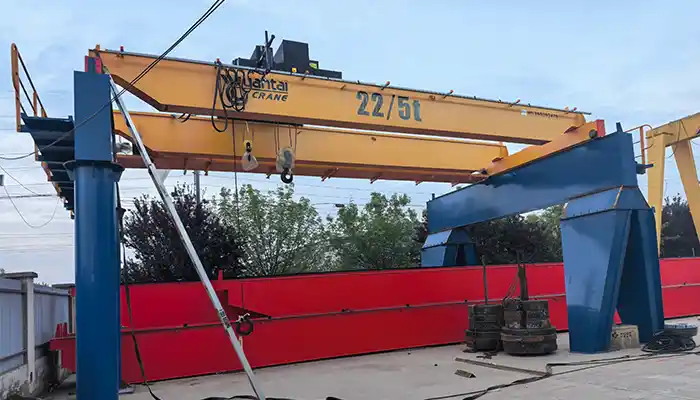
22/5 Ton Overhead Crane Double Hook System: Robust double girder crane with 22-ton main and 5-ton auxiliary hooks for heavy lifting. Get double hook crane!
Free consultation to Confirm Parameters & Specifications and Get
Latest Crane Price & Crane Rate.
- Types of overhead cranes : _______?
- Optional: Overhead travelling crane, goliath gantry crane,Slewing jib crane, Single girder or double girder crane,small portable crane or kbk crane, etc.
- Capacity of overhead crane: _______?
- Optional: 0.25ton, 0.5 ton, 1 ton, 2 ton, 3ton, 5 ton, 10 ton,15ton, 20ton, 25 ton, 30ton,35ton, up to 550ton, etc.
- Crane span & lifting height : _______?
- Crane travelling length : _____?
- Control of overhead crane:_______?
- Optional: pendant/ remote/cabin control
- Voltage supply of overhead crane:_____?
- Eg,: 380V50/60HZ,3Phase or others,etc.
- Application/usage of crane:_______?
- Eg,: Steel mill, ,injection mold, cement,stone, concrete,granite, general manufacturing, etc.
Just leave a message via the contact form and our hoist and crane engineer will contact you with in 24working hours.
Get In Touch
